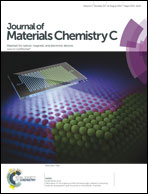Chain folding in main-chain liquid crystalline polyesters: from π–π stacking toward shape memory†
Abstract
A series of main-chain thermotropic liquid crystalline polyesters were synthesized by polycondensation from mesogenic dial such as 4,4′-bis(6-hydroxyhexyloxy)biphenyl (BHHBP) and various diacids with different substituents such as succinic acid (no side group), 2-methylsuccinic acid (aliphatic side group) and 2-phenylsuccinic acid (aromatic side group), named poly(4,4′-bis(6-hydroxyhexyloxy)biphenyl succinate) (PBDS), poly(4,4′-bis(6-hydroxyhexyloxy)biphenyl methylsuccinate) (PBDMS), and poly(4,4′-bis(6-hydroxyhexyloxy)biphenyl phenylsuccinate) (PBDPS), respectively. Liquid crystalline behaviours were investigated through differential scanning calorimetry (DSC), polarizing optical microscopy (POM) and small angle X-ray scattering (SAXS) and the thermal stability of the polyesters was determined via thermogravimetric analysis (TGA). PBDS, PBDMS and PBDPS showed a SmF, SmB and SmA phase, respectively. On enlarging the side group, the d-spacing of the smectic layer increased, indicating folding packing of the polymer chains. Therefore, the adjacent phenyl rings in side groups stacked well together and formed strong π–π interactions even when the temperature was higher than Ti. The special structure of PBDPS could provide good mechanical properties. Thus, PBDPS exhibited the maximum tensile stress (28.6 MPa) and the highest elongation at break (1060%). Furthermore, the strong π–π interaction can act as netpoints; therefore, PBDPS exhibited excellent shape fixing (>99%) and shape recovery ratio (>99%) with large strain (>220%).


 Please wait while we load your content...
Please wait while we load your content...